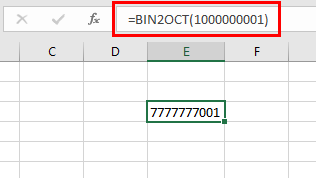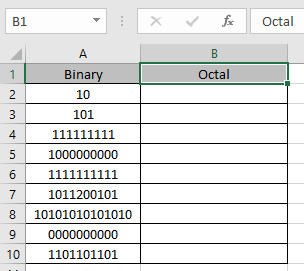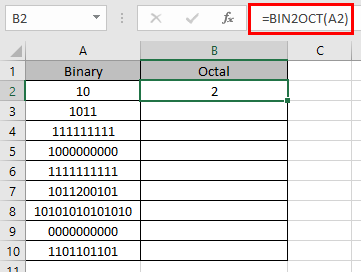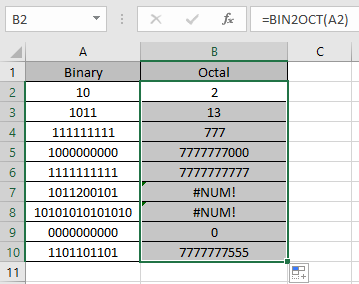In this article, we will learn about how to use the BIN2OCT function in Excel. BIN2OCT function in excel is used to convert binary representation of numbers of radix 2 to octal numbers (radix =8).
The table shown below shows you some of the most used base & their radix of Alpha - numeric characters
| Base | radix | Alpha-Numeric Characters |
| Binary | 2 | 0 - 1 |
| Octal | 8 | 0 - 7 |
| Decimal | 10 | 0 - 9 |
| hexadecimal | 16 | 0 - 9 & A - F |
| hexatridecimal | 36 | 0 - 9 & A - Z |
Binary number is representation of a number of radix 2. Only 2 digits are used in representation of a binary number 0 & 1. Where as octal number representation have 8 digits from 0, 1, 2, 3, 4, 5, 6, 7 The below table will help you understand better.
| Binary | Decimal | Octal |
| 0000 | 0 | 0 |
| 0001 | 1 | 1 |
| 0010 | 2 | 2 |
| 0011 | 3 | 3 |
| 0100 | 4 | 4 |
| 0101 | 5 | 5 |
| 0110 | 6 | 6 |
| 0111 | 7 | 7 |
| 1000 | 8 | 10 |
Conversion formulation is shown below:
Let’s take an example having 4 bits.
0111 (binary) = 23x 0 + 22x 1 + 21x 1 + 20x 1 = 7 (Octal)
The BIN2OCT function converts the binary number of radix 2 to the octal number of radix 8.
Syntax:
Number : binary number. Number cannot contain more than 10 characters (10 bits)
[Places] : [optional] number where result expressed upto the number.
The input value to the function cannot contain more than 10 characters ( 10 bits ). Where first number returns the sign of the number (positive or negative) & Other 9 returns the value after the sign. ( 1 for negative & 0 for positive).

To get the negative number, input number must have 10 characters starting with 1 as it represents the negative sign. The negative number is calculated using two's complement notation. Any less than 10 characters, the function considers default 0s in front. Any more than 10 characters, the function returns the #NUM! Error.
Now let’s get more understanding of the function via using them in some examples.

Here we have some binary values in Binary Column. We need to convert these binary numbers to octal value.
Use the formula in octal column:
A2 : number provided to the function as cell reference
Values to the BIN2OCT function is provided as cell reference.

The BIN2OCT representation of 10 of base 2 (binary) is 2 of base 10 (octal).
Now copy the formula to other cells using the Ctrl + D shortcut key.

As you can see here the BIN2OCT function returns the result of the input values.
Notes:
Hope you understood how to use BIN2OCT function and referring cell in Excel. Explore more articles on Excel mathematical conversion functions here. Please feel free to state your query or feedback for the above article.
Related Articles
How to use the Excel LN function
How to use the IMEXP Function in Excel
How to use the IMCONJUGATE Function in Excel
How to use the IMARGUMENT Function in Excel
How to use the COMBIN Function in Excel
How to use the PERMUT Function in Excel
Popular Articles
The applications/code on this site are distributed as is and without warranties or liability. In no event shall the owner of the copyrights, or the authors of the applications/code be liable for any loss of profit, any problems or any damage resulting from the use or evaluation of the applications/code.